Nissan Z-2023: Review

Nissan Z: Surprisingly, the new Z has the same platform as its 370Z predecessor from about 2009, right down to the Z34 chassis number, but the company has upgraded it so extensively that few will notice. All-new architecture may have been put on hold in this EV-focused era due to economies of scale, but the new Z is a taste of nostalgia in a stunning, retro-chic form.
The Z’s overhaul includes a new 400-horsepower, twin-turbo V6, a new nine-speed automatic gearbox, a new six-speed manual, launch control, considerable structural reinforcements to its shell, and many suspension improvements. Additionally, even on versions with manual transmissions, there is a genuine standard entertainment system and, for the first time, contemporary active safety measures.
The Z is still a reasonably priced vehicle for what it is despite having a base price that is about $10,000 more than previously due to all this added equipment. The essential Z Sport sits well between quicker, more costly sports cars like the Toyota Supra 3.0 and its open-topped sister, the BMW Z4, or Jaguar’s F-Type and cheaper, lighter ones like the Mazda MX-5 Miata, the Subaru BRZ/Toyota GR86 twins. It will display the taillights of a few more expensive four-cylinder vehicles, such as the Porsche 718 Cayman or the Supra 2.0, although other similarly priced V8 domestic muscle vehicles are quicker.
During our recent trip through Las Vegas, we dispelled any worries that the 2023 Z was a 370Z that had been warmed up. The car’s approximately 200-pound weight gain over the 370Z was more than compensated by a firmer chassis, more intuitive steering, upgraded gearboxes, and a 20% increase in power. The Z is a joy to drive fast; turning off the traction control lets your inner Ken Block loose. It isn’t as responsive as a Miata or quick in a straight line as a 5.0 Mustang.
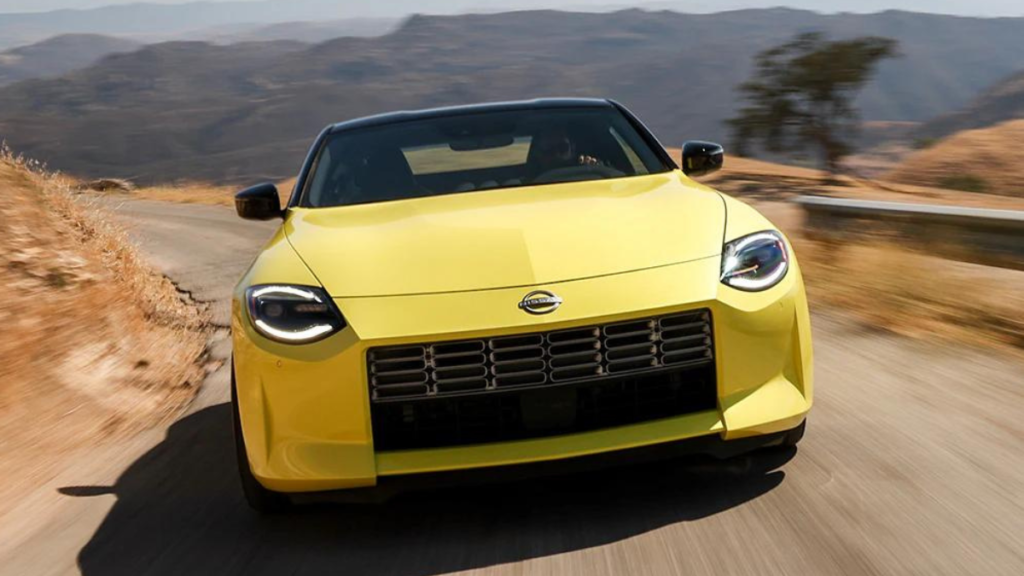
Nissan successfully drew inspiration from its history for the Z’s aesthetic elements. The designers used design influences from the previous six Z vehicle models to create an immediately identifiable, retro-modern appearance. Although the interior is less daring, the Z’s cabin makes a good traveling companion. On a track day, a driver as tall as six feet four may sit comfortably for hours while wearing a helmet. Modern driver information and infotainment displays with CarPlay and Android Auto are part of the interior revamp.
Additionally, there are new active safety measures. Sports car purchasers are used to receiving preferential treatment in this regard, but even manual Zs come standard with clever cruise control and automated emergency braking. There will be three initial models: the $41,015 Sport ($54,015, all prices include destination), the $51,015 (which receives several mechanical and aesthetic modifications), and the limited-run Proto Spec ($54,015, all prices include destination). The more expensive models face tougher competition, but the new Z doesn’t fall short on elegance or enjoyment.
What’s New?
- The 2023 Nissan Z is extensively revamped with a strengthened body structure and drastically different, retro-inspired look, yet it shares the same base as the original 370Z.
- With an increase of 20% and 30% above the previous 370Z V6 engine, a new twin-turbo V6 engine, similar to the one in the Nissan GTR, produces 400 horsepower and 350 pound-feet of torque.
- A lighter, smoother-shifting six-speed manual gearbox with optional rev-matching joins an entirely new nine-speed automatic transmission.
- The Z has an entirely new infotainment system with an 8- or 9-inch screen, Apple CarPlay, and Android Auto as standard.
- For the first time, the Z receives active safety features. All manual and automatic trims come standard with rear cross-traffic warnings, blind spot monitoring, lane departure warning, and automated emergency braking with pedestrian recognition.
Performance: Nissan Z
The 2023 Nissan Z is the most powerful ever, with its twin-turbo 3.0-liter V6 producing 400 horsepower and 350 pound-feet of torque. All that power is sent to the Z Performance’s large rear tires, which may be up to 275mm in diameter, through a revamped six-speed manual or an optional, brand-new nine-speed automatic. It is more responsive and accurate in the twisties than the previous 370Z, thanks to a sturdier chassis, a new power steering system, and updated suspension geometry. However, you can still feel its weight compared to lighter vehicles like the Miata and BRZ. However, it is more interesting than the Supra.
Even thousands of dollars in warranty-voiding engine modifications won’t make a BRZ or Miata this quick in a straight line. It may not be as light and responsive as its smaller, less expensive competitors, but the Z easily outperforms them. However, Nissan hasn’t provided a zero-to-60 time, so it’s unclear how quick it will be. Even though we did not conduct an instrumented test, we estimate the BMW M240i’s zero-to-60 time to be in the low to middle 4-second range, making it slower than the 3.0 Supra, V8 Mustang GT, or 3.0 Supra, all of which are excellent race cars.
The Z is about old-school fun and is the antithesis of chilly, silent, and clinical. All gas-powered sports cars are losing ground to new-school EVs in straight-line comparisons, but the Z is all about old-school pleasure. Check out our first driving report for more information on how the Z feels on the road and the track.
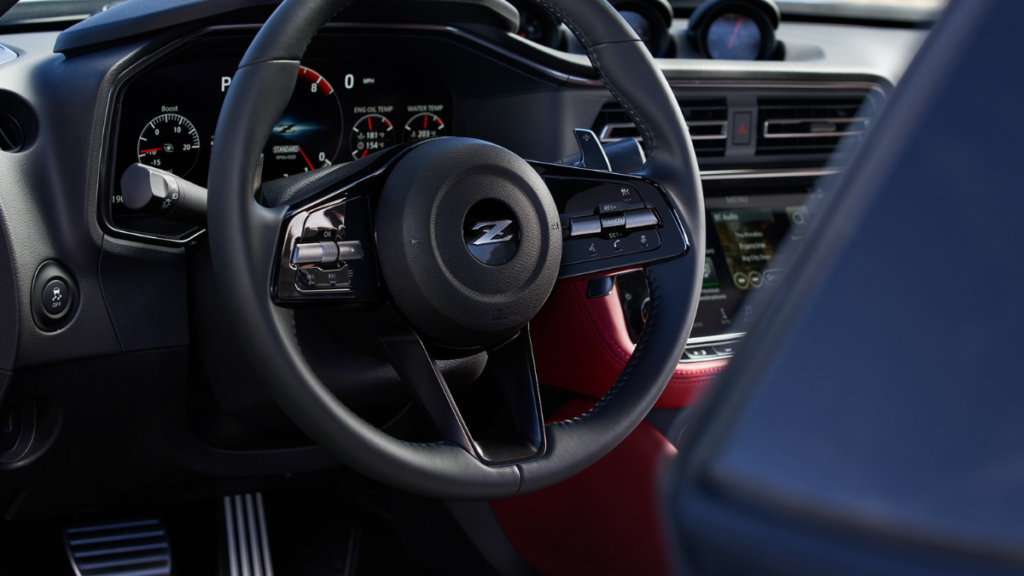
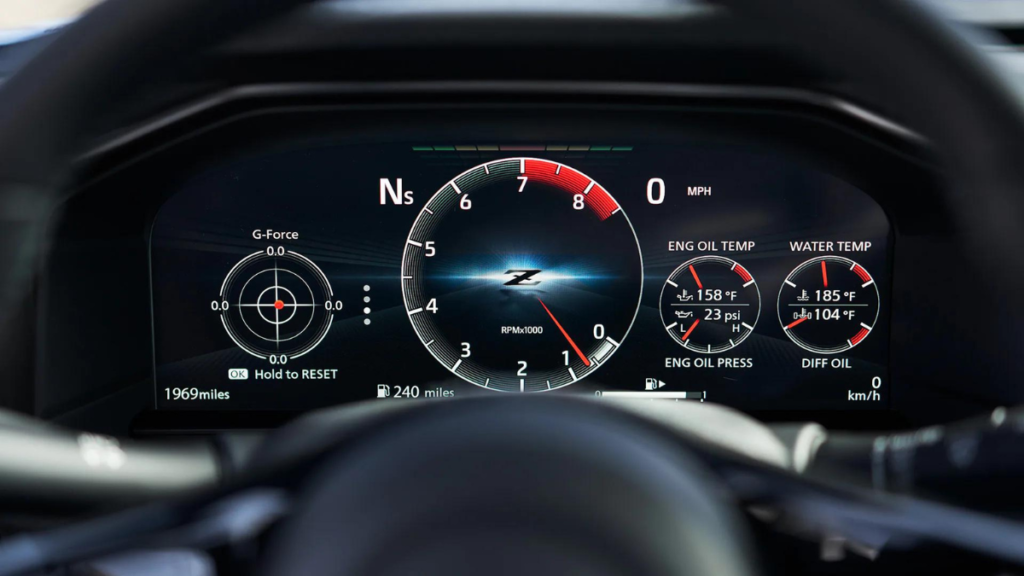
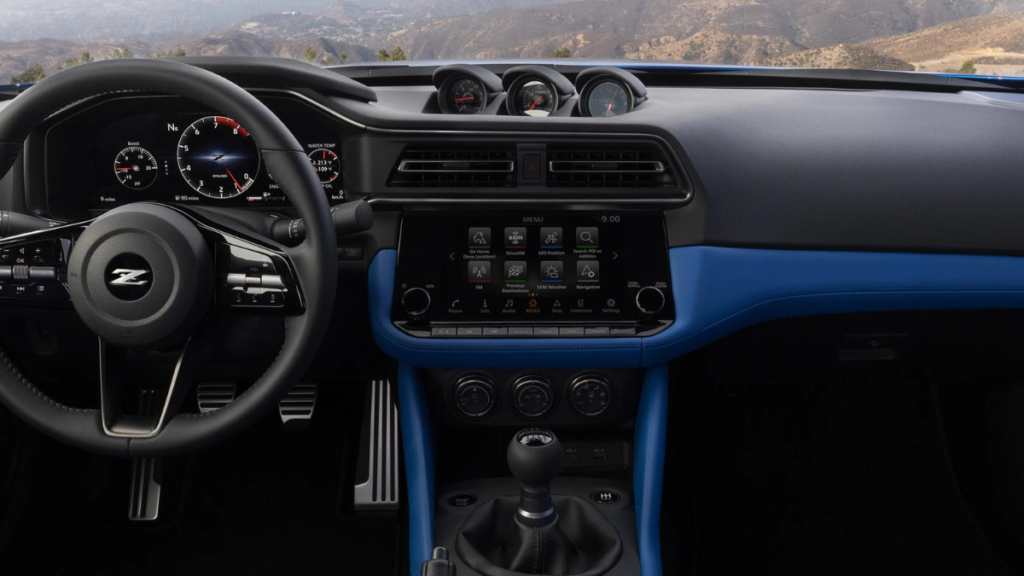
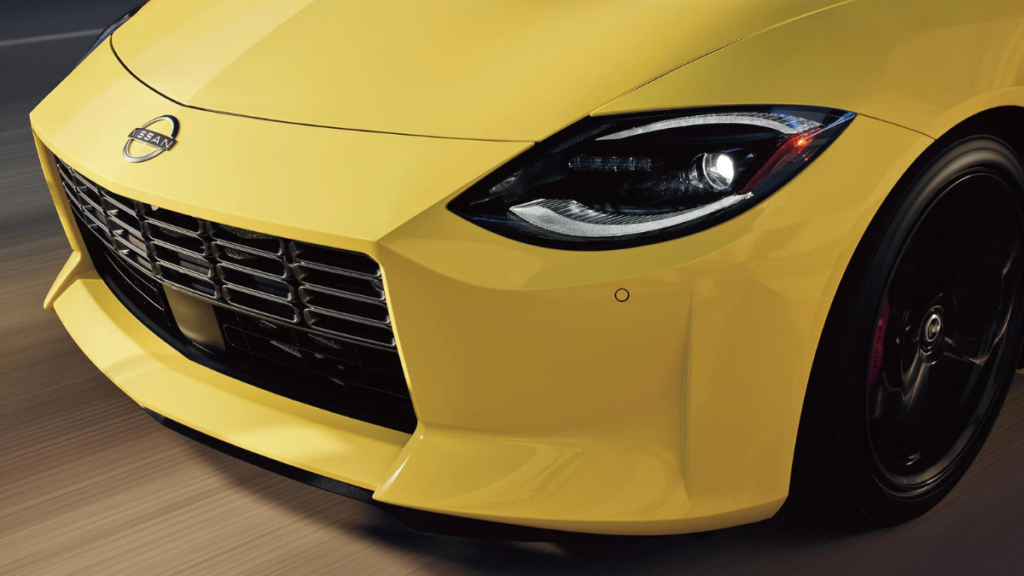
Fuel efficiency: Nissan Z
The EPA rated the manual gearbox Z at 18 mpg in the city, 24 mpg on the highway, and 20 mpg overall. Automatics return 19, 28, and 22 combined for cities. Even though the new 370Z is heavier and has more horsepower than the previous one, it averages around two more miles per gallon. However, our first drives in manual and automatic Zs gave us the impression that you must drive carefully to get these figures. Even if fuel efficiency is far from a Z-car buyer’s first concern, that’s still average.
The Jaguar F-Type gets 26 mpg combined, the Porsche 718 Cayman gets 24, while the four- and six-cylinder Toyota Supras get 28 and 25 mpg, respectively. While the automatic Subaru BRZ gets 25 mpg combined, the manual version gets almost the same economy as the Z. The slim and light Miata from Mazda receives 29 or 30 mpg when paired with an automatic or manual transmission, depending on the situation.
Safety & Driver Support
The Insurance Institute for Highway Safety (IIHS) and the National Highway Traffic Safety Administration (NHTSA) have not evaluated the 2023 Nissan Z. Because of this, it loses some points in our rating; nevertheless, apart from the BRZ/GR86 twins, the majority of its rivals are in a similar situation. These organizations don’t constantly evaluate sports vehicles.
The BRZ/GR86 gets Top Safety Pick+ ratings from IIHS. Still, those ratings only apply to the two vehicles’ automatic transmission variants, which have a wide range of driver-assist features. In manual and automated Z models, Nissan offers frontal collision warnings, automatic emergency braking with pedestrian recognition, lane departure alerts, and adaptive cruise control. Some of these systems are absent from far more costly equivalents.
Comfort & Room:
Only two individuals can fit in the Z, yet even tall people will feel quite at home. We determined that, unlike the Miata, a six-foot-four-inch individual can comfortably wear a big racing helmet in the Z. On paper, the Supra has a little more headroom than the Z, but the Z seems more comprehensive in person. Individual drivers may have different perspectives, but the Z is a more comfortable long-distance tourer and daily driver for tall people than many of its closest rivals.
The seats are firm and supportive without being too bolstered, unlike certain BMW M vehicles’ track-day-focused chairs. In contrast to other sports vehicles, getting in and out doesn’t involve any uncomfortable pretzeling. You could spend several hours in these seats and not feel tired or achy, just as in the non-M BMW 2 Series or 4 Series coupes, yet they’ll still hold you firmly on the autocross. For improved control, a new telescopic steering wheel is also helpful.
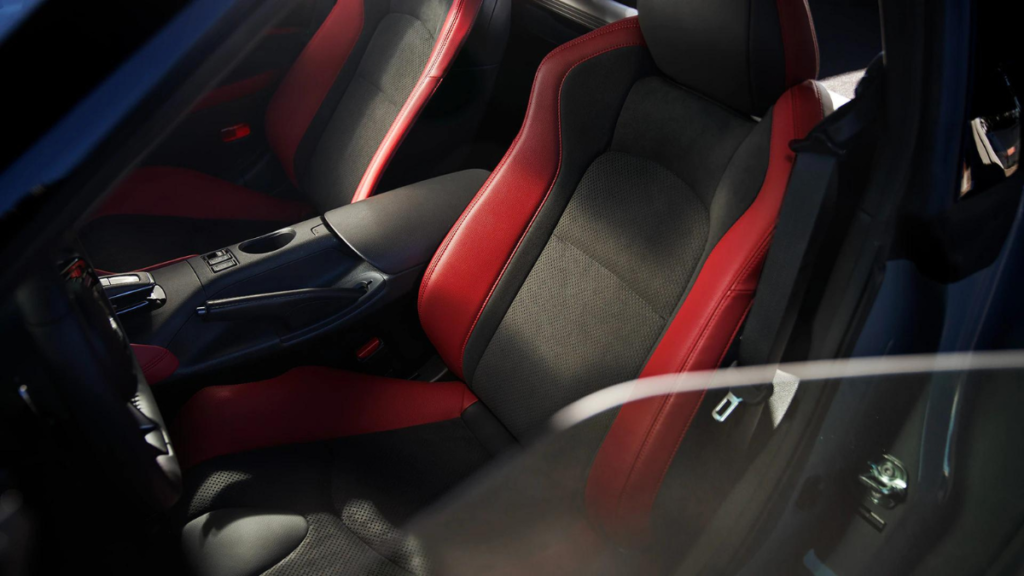
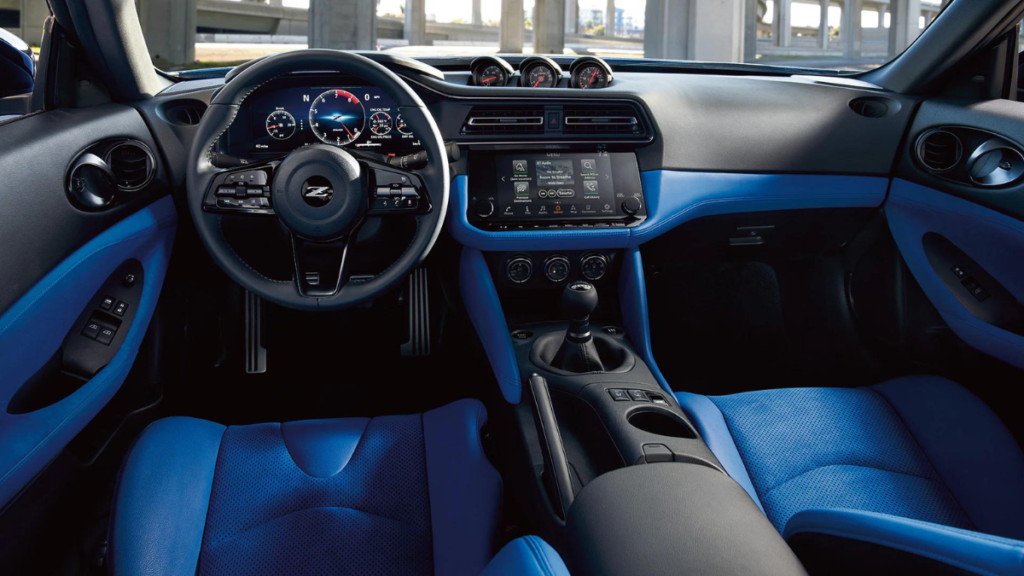
Infotainment: Nissan Z
For 2023, the Z will have a suitable infotainment system. Even the most basic system on the previous 370Z was only available on the top models. Now, Z Performance variants have a 9-inch unit with navigation and an 8-speaker Bose system, while Z Sport models begin with an 8-inch screen and a 6-speaker audio system. Although the analog turbo boost, turbine speed, and voltmeter gauges remain on top of the dash as a tribute to earlier Z-cars, the driver’s display is now totally digital and looks fantastic.
Nissan’s systems are simple to use and have decent visuals, although specific inputs may be a bit sluggish, and the pinch-zoom navigation function on the 9-inch panel was annoyingly inaccurate. Even though the visuals on the backup camera are dated, many of the basic controls are still there, and there isn’t much glare. Although not wireless, Apple CarPlay and Android Auto are standard for drivers who prefer the interfaces of their smartphones. One of the USB-A and C ports is available.
Storage & Cargo Space:
Nissan did not provide a cargo capacity for the Z. Still, given that the shell’s construction closely resembles the outgoing 370Z, it is reasonable to conclude that the Z has a volume of around seven cubic feet. You must be creative to keep anything in the Z’s small hold since the space is unorthodox, and there are several mechanical incursions from the rear suspension and hidden mechanical parts beneath. This is more space than the Miata and more functional than the Cayman but less space than the Supra, GR86, or BRZ.
Design: Nissan Z
Although the construction of the 2023 Z is similar to that of the outgoing 370Z, the car’s lines have been drastically revised with influence from earlier Z-cars. The C-pillar emblem is identical to the one on the original 240Z, the taillights are modeled after the Z32 from 1989, and some of the boxier features are reminiscent of the 300ZX from 1983 and the 350Z from 2002. Much like an Avalanches album, these timeless hooks are combined to produce something fresh and enjoyable.
The Z is stylish and attractive in every aspect while maintaining a classic aesthetic. It has more presence than the BRZ/GR86 twins, is slinkier than the BMW 2 Series, and has none of the GR-Supra’s curved oddity. Drivers of other, older performance vehicles often waved, honked, and snapped photos of us throughout our journey, which is its type of endorsement. Although the inside of the Z is significantly less avant-garde and luxurious-feeling than the Supra, it nevertheless looks beautiful. It offers a nice pop of available color.
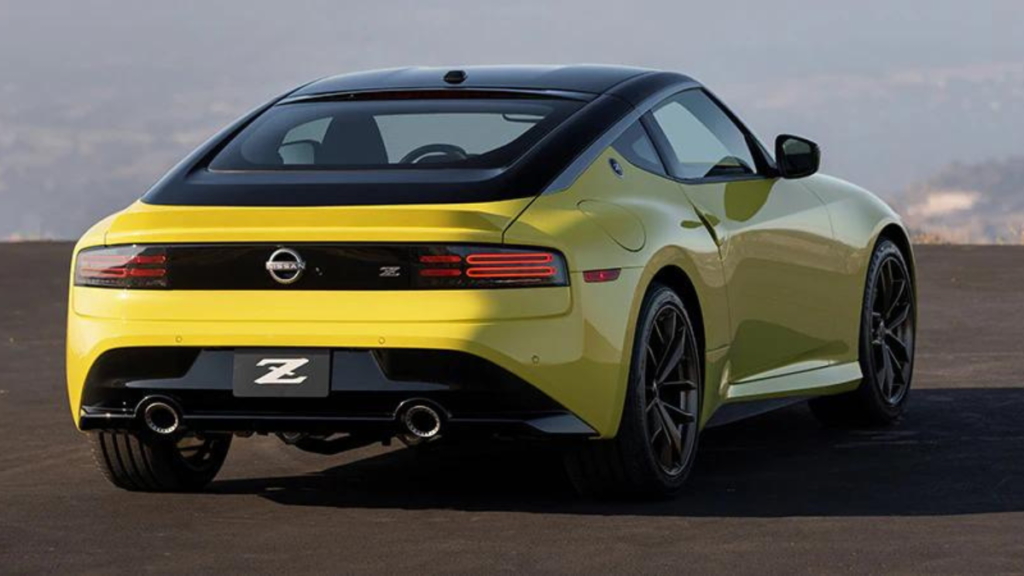
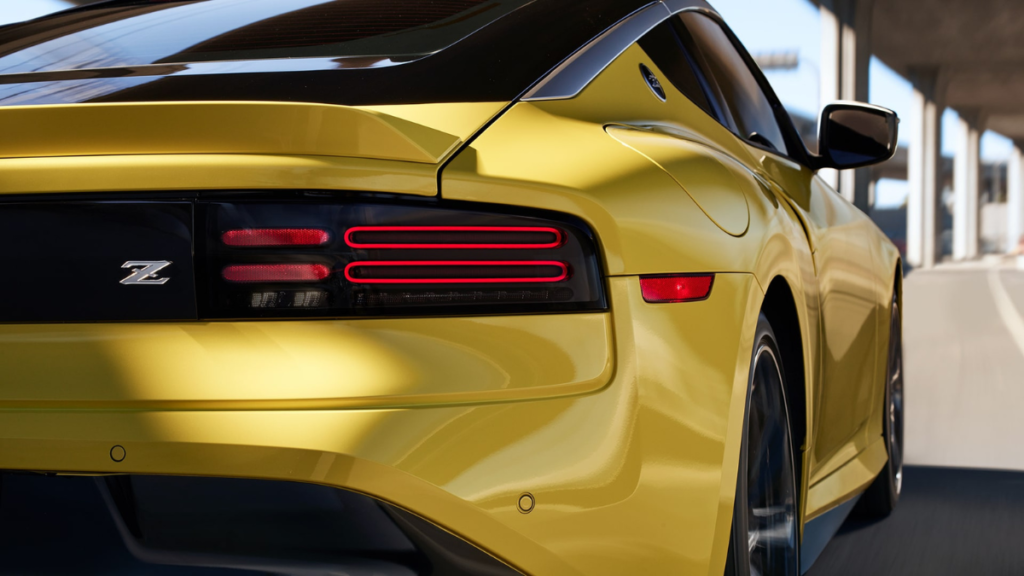


Is the Nissan Z worth it in 2023?
Yes, and we believe that the Z Sport basic model is where we would invest our money.
The base price of the Z Sport is $41,015 plus a $1,025 destination charge. That’s a massive price increase of $10,000 above the base-model 370Z for 2020, and it costs nearly as much as the Subaru BRZ Limited. However, customers are receiving far more than before, such as contemporary infotainment and active-safety technologies, much greater power, and the car’s updated design.
The Sport misses specific vital characteristics of the Z Performance ($51,015), most notably its limited-slip differential, significantly stronger brakes, and wider wheels and tires. However, it strikes a balance between pricing and power that sets it apart from its rivals. The Z easily outperforms the BRZ, GR86, and Miata while being more affordable, lighter, and responsive. The BMW M240i costs $9,000 more, the four-cylinder GR-Supra $4,000 more, and equivalents from Audi, Jaguar, and Porsche cost much more.
The Z Performance is the full-fat experience, and its extra mechanical enhancements count. Said, speedier rivals at a comparable price point exist in the form of the M240i, Supra 3.0, and V8 Mustang GT. Two hundred forty limited-edition Proto Specs ($54,015) will also be produced. It is identical to a Z Performance save for the excellent leather seats with yellow highlights, the unique yellow inside stitching, brake calipers, and the gold 19-inch RAYS rims.
How much does insurance for a 2023 Nissan Z cost?
There is no information on the precise insurance cost as the Z hasn’t yet reached dealerships. But if the 370Z and the car’s rivals are any indication, it won’t be cheap. A typical 30-year-old female driver with a clean driving record will likely pay a $2,500 to $3,100 premium. Comparatively, the Porsche 718 Cayman costs $2,623 (and more for the S and RS variants), the Toyota Supra Premium 3.0 costs $2,476, and the Audi TTS Quattro costs $3,056. At $2,233 and $1,753, respectively, the Subaru BRZ and Mazda MX-5 Miata are much less expensive.

Nissan Z Generations
Seventh Generation
2023 to Present
2023 is the seventh generation of Nissan’s illustrious Z-car and the first to do away with the number identification of its 240Z-era predecessors. Despite sharing the same platform architecture as the sixth-generation 370Z, Nissan claims its engineers have made nearly 80% of the changes to the vehicle, including strengthening the body, altering the suspension geometry, and adding a new engine, nine-speed automatic transmission, redesigned six-speed manual gearbox, and numerous other mechanical upgrades.
With the Q60 Red Sport from Infiniti, the 3.0-liter 400-horsepower, 350-pound-foot twin-turbo V6 now provides the power. The engine is related to the Nissan GTR’s 3.8-liter, 565-horsepower engine. Modern infotainment is also included, along with active safety features like adaptive cruise control and automated emergency braking for the first time. The new Z’s gorgeous retro-chic exterior appearance is its best feature.
Sixth Generation
2009 to 2020
The “Z34” 370Z was released as a 2009 model in late 2008 and was available as a roadster and a coupe. It was based on the platform architecture of the 350Z from the early 2000s. There was also a Nismo variant with even more performance, a unique aerodynamic body package, and up to 350 horsepower. The 3.7-liter, customarily aspirated VQ37VHR V6 utilized in all standard variants, which had 332 horsepower, was shared with several Infiniti cars. Both automatic and manual gears, as on all prior Zs, were offered, with the latter gaining the first version of Nissan SynchroRev Match, which simulates “heel-and-toe” throttle manipulation. The 2012 refresh of the 370Z, a competitive vehicle when it was new, saw minor modifications going forward.
Fifth Generation
2003 to 2008
Nissan set out to reimagine the Z-car for the new century after it was discontinued in North America in 1996 and domestically in 2000. The outcome was the 350Z, a vehicle built on the same chassis as the Nissan Skyline and, therefore, the Infiniti G-Series. The 350Z was a dramatic-looking car that pioneered new territory in the Z-car line and drew power from a naturally-aspirated 3.5-liter V6, first making 287 horsepower and later 300, channeled through automatic or manual transmissions. It was part of Nissan’s design revival after a protracted decline in the 1990s. A roadster with an open top joined the 350Z coupe in 2004. The 350Z was a well-liked vehicle when it was new, and its notoriety increased because of its appearance in the 2006 film “Fast and Furious: Tokyo Drift.”
Fourth Generation
1989 to 1996
The “Z32” 300ZX was purposely intended to deliver close to supercar-levels of performance and traditional gran turismo comfort in the 1980s, during the height of the Japanese economic boom. Aerodynamic and fashionable, it raised the performance and pricing of the Z-car to new heights. Available with up to 300 horsepower, the 300ZX’s 3.0-liter V6 engines, which could be naturally aspirated or turbocharged, made it one of the fastest seductive cars on the market in 1990. With a pace from zero to sixty in just five seconds, the twin-turbo variant is still considered fast today. Despite being beautiful to look at and drive, the 300ZX’s higher price was at odds with the early 1990s recession and the waning appeal of Japanese sports cars. In 1996, it was taken off the American market, and in 2000, manufacture was stopped. There was a short convertible version of the Z32.
Third Generation
1984 to 1988
The wedge-shaped Z31 was the first Z-car to employ a V6 engine rather than an inline-six and was also the first to carry the 300ZX moniker. The 300ZX was designed to capitalize on the qualities customers enjoyed about the second-generation S130 model, while succeeding Z vehicles would attempt to capture the essence of 1970 original. It was a sports vehicle with a larger wheelbase and a high-tech, comfortable GT option. Electronically adjustable shock absorbers, an LED brake light assembly, and a “voice warning system” that uttered numerous notifications concerning vehicle state were just a few examples of the new, pervasive technology. 3.0 liter V6 engine with optional turbocharging and up to 205 horsepower provided the power. There were various special editions, including an anniversary and a “Shiro Special” that was simplified and back to the fundamentals.
Second Generation
1979 to 1983
The second-generation Z-car, commonly known as the 280ZX and designated by the internal development code S130, got bigger and heavier in 1979 but also had unprecedented sales. To contemporary eyes, the 280ZX might seem lazy, but in the lean performance years of the early 1980s, it was a hot number. It was a legitimate challenger to both muscle cars and emissions-strangled exotics equally. Like its predecessor, it had a 2+2 type with a larger wheelbase, and the interior was noticeably more opulent. The 280ZX could easily outswing Pontiac Trans-Ams and Monte Carlos from the disco era. Improvements were made to several technology systems, including aerodynamics and emissions. A 180-horsepower turbocharged version of the 2.8-liter inline six that provided the power was an option.
First Generation
1970 to 1978
The original 240Z, a replacement for Nissan’s Fairlady roadsters from the 1960s, established the company as producing desirable goods. The original “Fairlady Z” destroyed MGCs and Triumph TR-6s on performance, quality, and dependability, directly aiming at the heart of classic sports cars like MGs and Triumphs. This demonstrated to the then-skeptical world that a Japanese automobile could be a world-beater in the most competitive areas. A vehicle that could compete with tiny sports cars and the expanding market for compact sporty coupes like the Ford Capri and Toyota Celica was a goal for designer Yoshihiko Matsuo and well-known U.S. market product executive Yutaka Katayama.
The Z was quite athletic and had an extremely appealing style when it was first released, but power was reduced over time due to pollution restrictions, which required a bigger engine. According to customer expectations, the car’s size and weight rose. In 1974, the same year the vehicle evolved into the 260Z, a long-wheelbase 2+2 variant was released.

Verdict
The 2023 Nissan Z utilizes the same base as its predecessor from about 2009 but is significantly updated in technology and aesthetics, to say nothing of a significant increase in power. The carmaker has given the Z 400 twin-turbocharged horsepower, reinforced its chassis, updated its handling, and covered it in a retro-modern form that is stunning from every perspective. A contemporary entertainment system and active safety measures (even on manual models) are also included in the Z vehicle. The new Z, all about old-fashioned pleasure, isn’t as quick as some more expensive rivals, but it’s a blast to drive and simple to live with.




